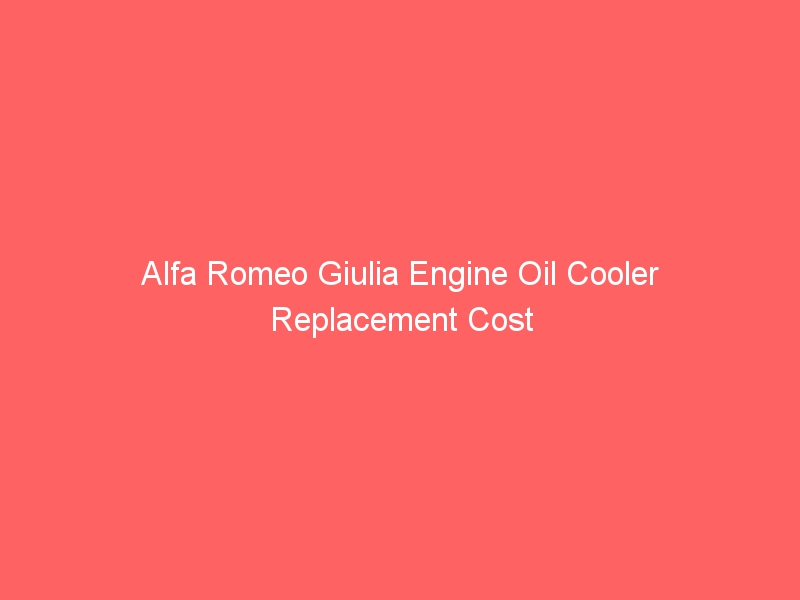Alfa Romeo Giulia Engine Oil Cooler Replacement Cost
Unveiling the Alfa Romeo Giulia Engine Oil Cooler Replacement Cost: What You Need to Know
The Alfa Romeo Giulia Engine Oil Cooler Replacement Cost typically falls between $459 and $546. This estimate covers both parts and labor, with labor costs averaging between $334 and $422, and the oil cooler itself priced around $124. It's crucial to remember that this range is a national average and doesn't account for taxes, fees, or your specific geographic location, which can significantly influence the final bill.
Understanding the Alfa Romeo Giulia Engine Oil Cooler Replacement Cost
When your Alfa Romeo Giulia's engine oil cooler needs attention, understanding the financial implications is paramount. The figures provided offer a clear snapshot of what you can expect.
| Cost Component | Estimated Range |
|---|---|
| Total Cost | $459 – $546 |
| Labor Costs | $334 – $422 |
| Parts Cost | $124 |
Please note: This data represents a national average. Your actual cost may vary based on several influential factors.
Factors Influencing Your Specific Alfa Romeo Giulia Engine Oil Cooler Replacement Cost
While the average figures provide a baseline, several variables can sway the Alfa Romeo Giulia Engine Oil Cooler Replacement Cost for your specific situation:
- Your Geographic Location: Labor rates vary considerably by region. Major metropolitan areas often have higher service costs compared to rural areas. Dealerships in high-cost-of-living areas will likely charge more than independent shops.
- Mileage and Vehicle Age: As your Giulia accumulates miles, components can become more seized or difficult to remove, potentially increasing labor time. Older vehicles might also have parts that are harder to source, impacting the parts cost.
- Type of Repair Shop:
- Dealerships: Generally offer the highest level of expertise and OEM (Original Equipment Manufacturer) parts, but often come with a premium price tag.
- Independent European Specialists: Can offer a good balance of expertise and cost, often using quality aftermarket parts or OEM parts at a slightly lower markup.
- General Auto Repair Shops: May have less specialized knowledge of Alfa Romeo systems, potentially leading to longer diagnostic times or less optimal repairs.
- Your Geographic Location: Labor rates vary considerably by region. Major metropolitan areas often have higher service costs compared to rural areas. Dealerships in high-cost-of-living areas will likely charge more than independent shops.
- Mileage and Vehicle Age: As your Giulia accumulates miles, components can become more seized or difficult to remove, potentially increasing labor time. Older vehicles might also have parts that are harder to source, impacting the parts cost.
- Type of Repair Shop:
- Dealerships: Generally offer the highest level of expertise and OEM (Original Equipment Manufacturer) parts, but often come with a premium price tag.
- Independent European Specialists: Can offer a good balance of expertise and cost, often using quality aftermarket parts or OEM parts at a slightly lower markup.
- General Auto Repair Shops: May have less specialized knowledge of Alfa Romeo systems, potentially leading to longer diagnostic times or less optimal repairs.
Diagnosing Engine Oil Cooler Issues in Your Alfa Romeo Giulia
Accurate diagnosis is the first step in addressing any automotive problem, and your Alfa Romeo Giulia's engine oil cooler is no exception.
How are Engine Oil Cooler Issues Diagnosed?
When the oil cooler or its associated lines show signs of failure, a technician will often observe illuminated dashboard warning lights. These can include:
- Your Geographic Location: Labor rates vary considerably by region. Major metropolitan areas often have higher service costs compared to rural areas. Dealerships in high-cost-of-living areas will likely charge more than independent shops.
- Mileage and Vehicle Age: As your Giulia accumulates miles, components can become more seized or difficult to remove, potentially increasing labor time. Older vehicles might also have parts that are harder to source, impacting the parts cost.
- Type of Repair Shop:
- Dealerships: Generally offer the highest level of expertise and OEM (Original Equipment Manufacturer) parts, but often come with a premium price tag.
- Independent European Specialists: Can offer a good balance of expertise and cost, often using quality aftermarket parts or OEM parts at a slightly lower markup.
- General Auto Repair Shops: May have less specialized knowledge of Alfa Romeo systems, potentially leading to longer diagnostic times or less optimal repairs.
Before directly testing the oil cooler, a skilled technician will perform several other checks to rule out simpler causes:
- Your Geographic Location: Labor rates vary considerably by region. Major metropolitan areas often have higher service costs compared to rural areas. Dealerships in high-cost-of-living areas will likely charge more than independent shops.
- Mileage and Vehicle Age: As your Giulia accumulates miles, components can become more seized or difficult to remove, potentially increasing labor time. Older vehicles might also have parts that are harder to source, impacting the parts cost.
- Type of Repair Shop:
- Dealerships: Generally offer the highest level of expertise and OEM (Original Equipment Manufacturer) parts, but often come with a premium price tag.
- Independent European Specialists: Can offer a good balance of expertise and cost, often using quality aftermarket parts or OEM parts at a slightly lower markup.
- General Auto Repair Shops: May have less specialized knowledge of Alfa Romeo systems, potentially leading to longer diagnostic times or less optimal repairs.
If these sensors are functioning properly and the warning lights persist, the technician will then focus on the oil cooler itself.
Common Diagnostic Procedures for Engine Oil Coolers:
- Your Geographic Location: Labor rates vary considerably by region. Major metropolitan areas often have higher service costs compared to rural areas. Dealerships in high-cost-of-living areas will likely charge more than independent shops.
- Mileage and Vehicle Age: As your Giulia accumulates miles, components can become more seized or difficult to remove, potentially increasing labor time. Older vehicles might also have parts that are harder to source, impacting the parts cost.
- Type of Repair Shop:
- Dealerships: Generally offer the highest level of expertise and OEM (Original Equipment Manufacturer) parts, but often come with a premium price tag.
- Independent European Specialists: Can offer a good balance of expertise and cost, often using quality aftermarket parts or OEM parts at a slightly lower markup.
- General Auto Repair Shops: May have less specialized knowledge of Alfa Romeo systems, potentially leading to longer diagnostic times or less optimal repairs.
The Replacement Process: What to Expect for Your Alfa Romeo Giulia
Replacing an engine oil cooler on your Alfa Romeo Giulia is a precise procedure that requires specific knowledge and tools.
How are Engine Oil Coolers Replaced?
The general steps involved in an engine oil cooler replacement include:
- Accessing the Cooler: This may involve removing undertrays or other body panels to gain clear access to the oil cooler assembly.
- Disconnecting Lines: The oil lines connected to the cooler will be carefully disconnected. These lines carry the engine oil to and from the cooler.
- Removing Mounting Hardware: The fasteners or mounting brackets securing the old oil cooler will be unfastened.
- Installing the New Cooler: The new oil cooler is positioned and secured in place using the appropriate hardware.
- Reconnecting Lines: The oil lines are reconnected to the new cooler, ensuring a secure and leak-free seal.
- System Flush and Refill: The engine oil system will be flushed to remove any contaminants or debris. It will then be drained and refilled with fresh, high-quality engine oil, and the oil filter will be replaced as a standard procedure.
- Cooling System Integration (If Applicable): In some vehicle designs, the engine oil cooler might be integrated into the vehicle's main radiator. If this is the case, the engine cooling system will need to be drained, the radiator removed, and the cooling system refilled and properly bled after the repair is complete.
- Testing and Verification: After the replacement, the technician will drive the vehicle, closely monitoring oil pressure and temperature to ensure the new cooler is functioning correctly. Any relevant OBD (On-Board Diagnostics) trouble codes will likely be cleared, and the repair will be confirmed.
Warning Signs: When Your Alfa Romeo Giulia's Oil Cooler Needs Attention
Recognizing the symptoms of a failing engine oil cooler is crucial to prevent more severe engine damage.
What to Look Out For When Dealing with Engine Oil Cooler Issues:
- Your Geographic Location: Labor rates vary considerably by region. Major metropolitan areas often have higher service costs compared to rural areas. Dealerships in high-cost-of-living areas will likely charge more than independent shops.
- Mileage and Vehicle Age: As your Giulia accumulates miles, components can become more seized or difficult to remove, potentially increasing labor time. Older vehicles might also have parts that are harder to source, impacting the parts cost.
- Type of Repair Shop:
- Dealerships: Generally offer the highest level of expertise and OEM (Original Equipment Manufacturer) parts, but often come with a premium price tag.
- Independent European Specialists: Can offer a good balance of expertise and cost, often using quality aftermarket parts or OEM parts at a slightly lower markup.
- General Auto Repair Shops: May have less specialized knowledge of Alfa Romeo systems, potentially leading to longer diagnostic times or less optimal repairs.
Saving Money on Your Alfa Romeo Giulia Engine Oil Cooler Replacement Cost
While a necessary repair, there are ways to manage the Alfa Romeo Giulia Engine Oil Cooler Replacement Cost.
Money-Saving Tips:
- Your Geographic Location: Labor rates vary considerably by region. Major metropolitan areas often have higher service costs compared to rural areas. Dealerships in high-cost-of-living areas will likely charge more than independent shops.
- Mileage and Vehicle Age: As your Giulia accumulates miles, components can become more seized or difficult to remove, potentially increasing labor time. Older vehicles might also have parts that are harder to source, impacting the parts cost.
- Type of Repair Shop:
- Dealerships: Generally offer the highest level of expertise and OEM (Original Equipment Manufacturer) parts, but often come with a premium price tag.
- Independent European Specialists: Can offer a good balance of expertise and cost, often using quality aftermarket parts or OEM parts at a slightly lower markup.
- General Auto Repair Shops: May have less specialized knowledge of Alfa Romeo systems, potentially leading to longer diagnostic times or less optimal repairs.
Frequently Asked Questions About Alfa Romeo Giulia Engine Oil Cooler Replacement Cost
Q1: What is the average Alfa Romeo Giulia Engine Oil Cooler Replacement Cost?
The average cost for an Alfa Romeo Giulia Engine Oil Cooler Replacement is between $459 and $546, including parts and labor.Q2: How long does an Alfa Romeo Giulia Engine Oil Cooler Replacement typically take?
The labor time can vary, but it generally takes a few hours. Factors like accessibility and whether the oil cooler is integrated into the radiator can influence the duration.Q3: Can I replace the Engine Oil Cooler myself on my Alfa Romeo Giulia?
If you have the necessary tools, mechanical aptitude, and access to repair guides, a DIY replacement is possible. However, it's a task that requires precision, and improper installation can lead to leaks or further engine issues.Q4: How can I prevent issues with my Alfa Romeo Giulia's Engine Oil Cooler?
Regular maintenance, including adhering to the recommended oil change intervals and using the correct type of engine oil, is crucial. Additionally, avoid power washing the oil cooler, as this can flatten the fins and reduce its effectiveness. If cleaning is needed, use a radiator comb and lightly pressurized water in a clean environment.Is your Alfa Romeo Giulia showing signs of an oil cooler issue? Don't delay! Contact a trusted mechanic today to get a precise quote and ensure your engine stays cool and protected. Use our [Fair Price Estimator](link to your estimator) for a location-specific cost analysis.


